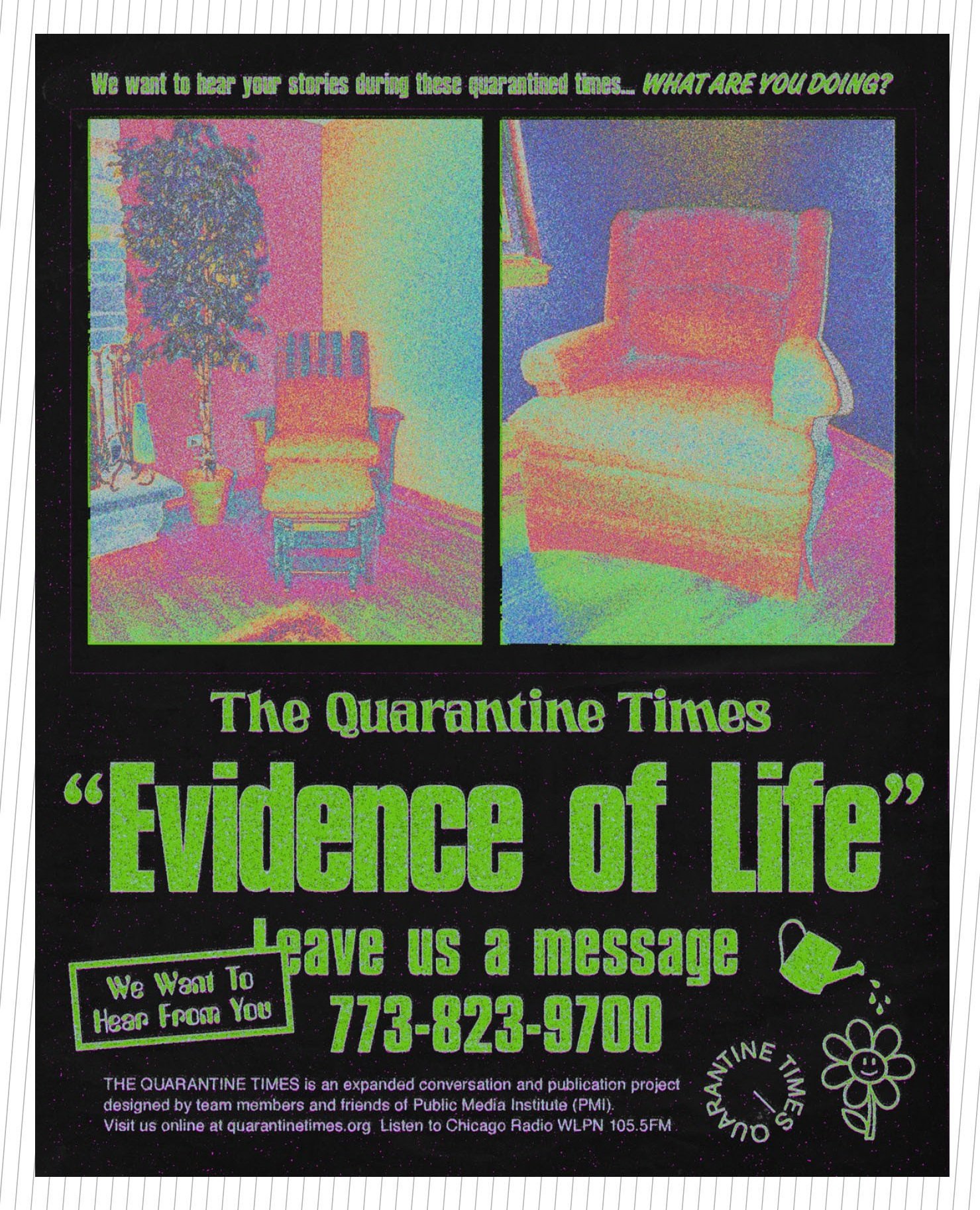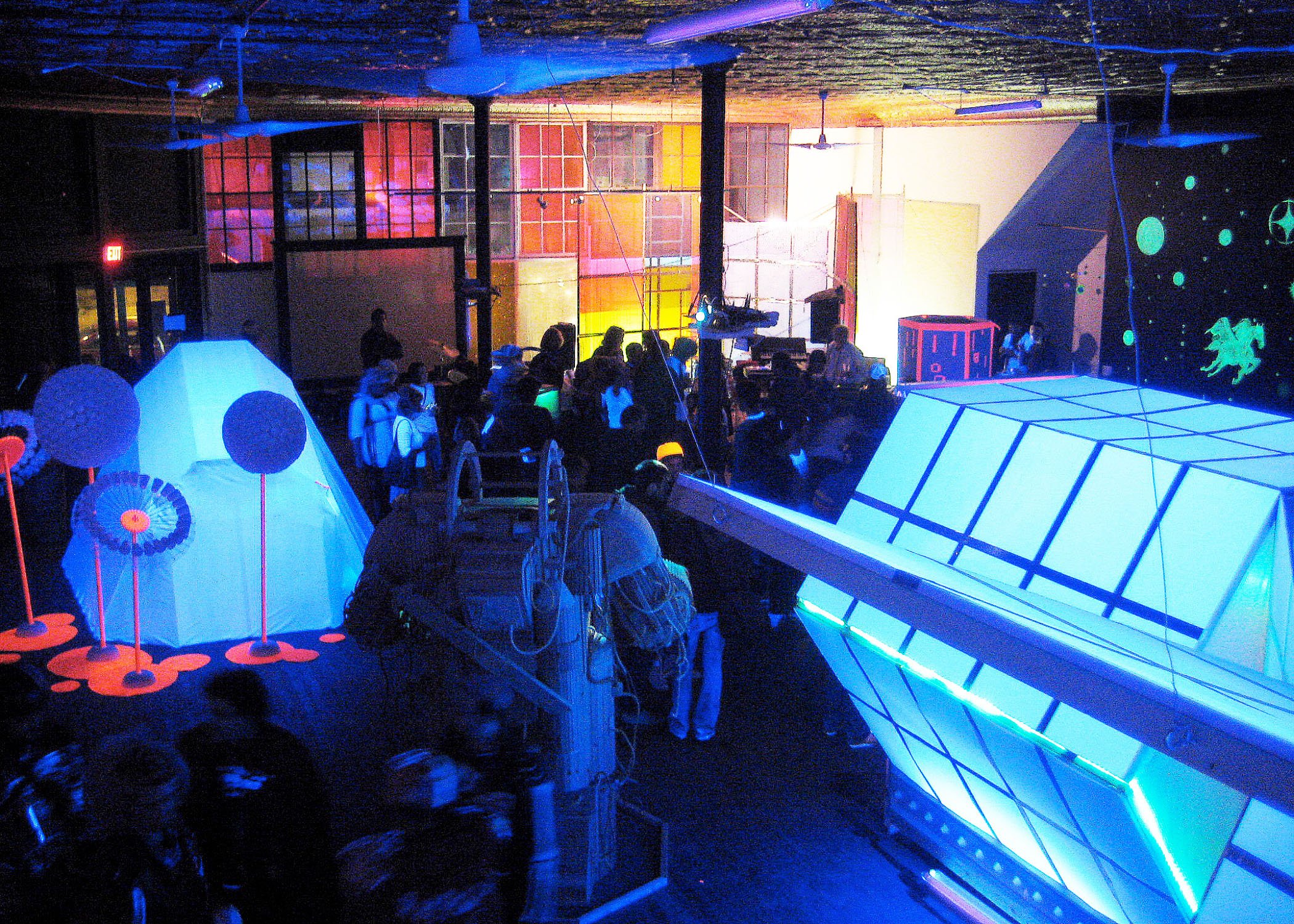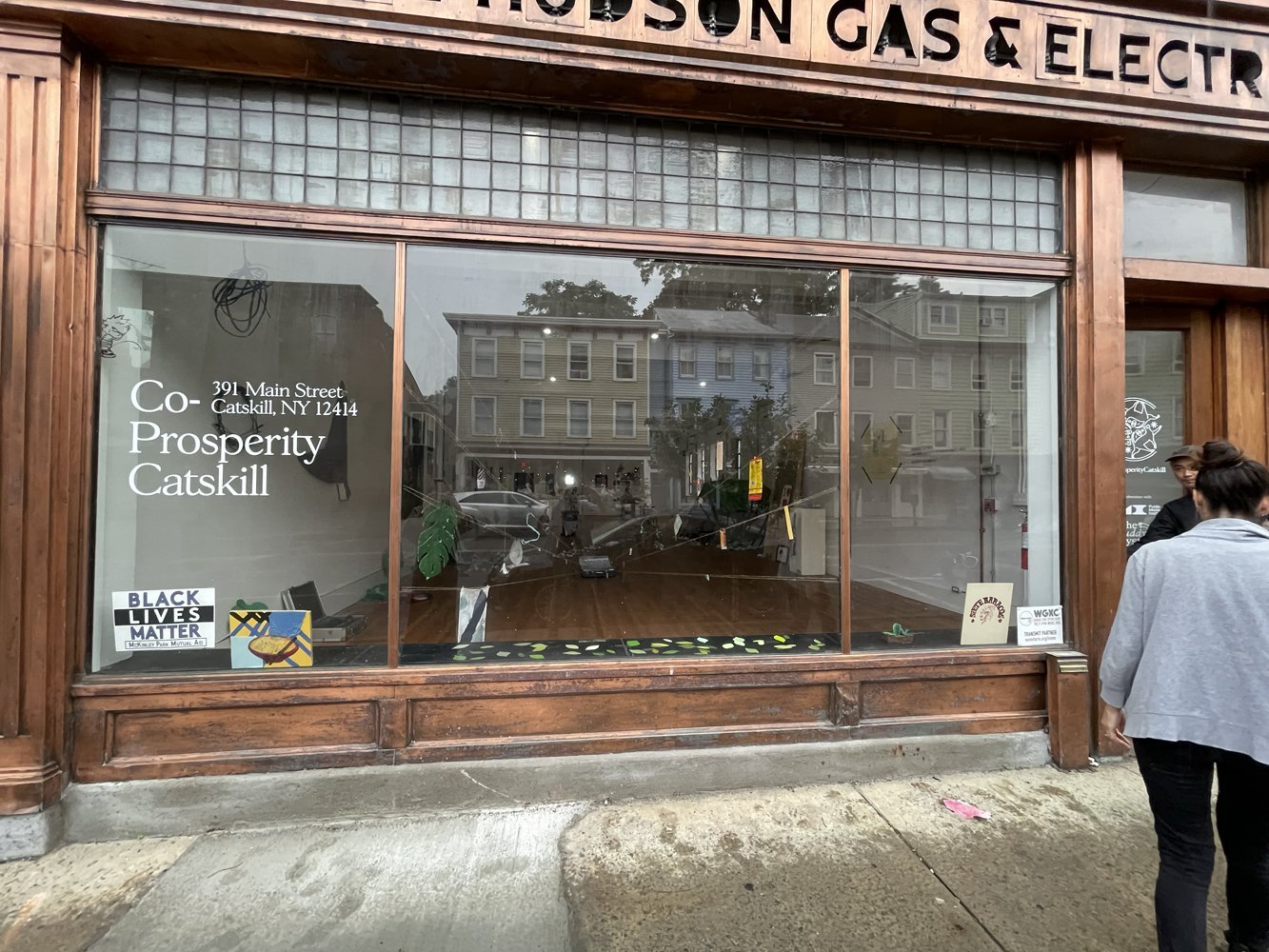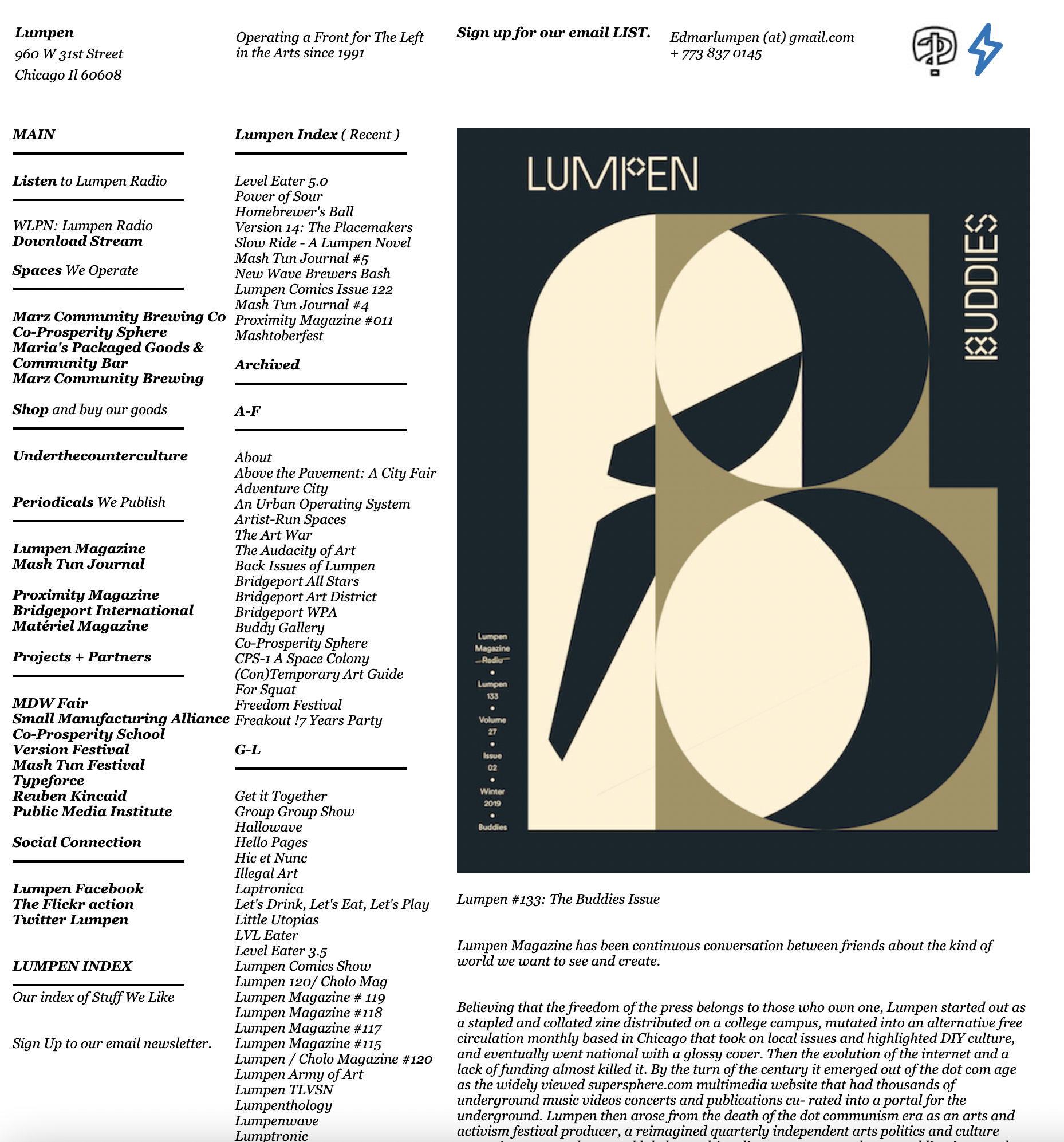Explore our archive of programs and events!
Growing Archives
A still-growing list of select exhibitions and events that have taken place at Co-Prosperity Chicago from 2015 to the present.
A continually growing archive of live broadcasted radio shows for you to dig through and listen to. So many interviews! So much music!
A continually growing archive of concerts, panels, workshops, performances, and otehr weird TV highlights for you to watch.
A continually growing archive of Lumpen magazine.
2024 Annual Report
Check out a little zine of a report about what PMI did in the bonkers year that was 2024
Recent Projects
Recent Projects
Community Kitchen & Canteen
(2020—Present)
How do we feed those in need?
In June 2020, inspired by the work of our neighbors and comrades, Public Media Institute launched the Community Kitchen as an effort to put the kitchens and staff of our partners at Kimski and Marz to work, and to feed hungry people. Meals were delivered five days a week to food pantries, senior housing complexes, community centers, hospital workers, and residents of Chicago. The program launched in early June, and by late July, the number of weekly meals distributed increased from 600 to 1,000. By January 2021, the program expanded to distribute almost 4,000 meals per week, and also launched a Community Canteen model, which allows folks to come pick up select free meals from a menu, and opt to “pay it forward” if they’d like more. The first location was at Kimski. A second was established at Iyanze Bronze in Bronzveille, and a third at Wherewithall in Avondale. Additional partner kitchens for the entire Community Kitchen program included DMen Tap, Iyanze Bronze, Whiner Brewery, Snakes and Lattes, and dozens of chefs from Chicago.
The Community Kitchen and Canteen were funded by emergency Covid relief funds by supporting foundations through the Spring of 2021. With the support of community members, individuals, and businesses from around the world, The Community Kitchen remains funded and supports the making of meals at Kimski once a week.
As of September 1, 2021, we had served more than 100,000 meals.
Quarantine Times
(2020—Present)
How do artists and activists respond to a pandemic?
The Quarantine Times (www.quarantinetimes.org) was produced by Public Media Institute and served as a COVID-19 emergency relief fund for more than 300 Chicago artists between March and August of 2020. Each day, PMI commissioned a new creative response to the pandemic, the uprising against police terror, and the breadth of hardship our communities experienced in 2020.
Days after the stay-at-home order in Illinois was issued by Governor Pritzker on March 17, 2020, a group of Super Friends (Brandon Alvendia, Elise Barrington, Logan Bay, Stella Brown, Mairead Case, Jeremiah Chiu, Marc Fischer, Marian Frost, Won Kim, Christy LeMaster, Stephanie Manriquez, Ed Marszewski, Jamie Trecker, Marina Resende Santos and Nick Wylie) assembled to edit the publication, and began the difficult task of introducing themselves and the project while trying to grasp the enormity of the wave that was coming. We saw the residents of Wuhan begin to emerge from quarantine as we watched the numbers worsen in Illinois, and read accounts of Cook County Jail being the largest epicenter in the world. In consultation with our partners, we extended the publication for one month, and then another. The content produced for Quarantine Times was compiled into a 500+ page perfect bound book designed by Jeremiah Chiu and Itsayana Campos, and was released in 2021.
Version and Select Media Festivals
(2002—2016)
How do we support and sustain a healthy art scene?
We were inspired by internet bulletin boards, startup web companies, and the new media arts scenes that erupted during the Dot Communism Age (1997-2001). Through our interactions with early digital upstarts (that wanted to commercialize the net) and their dissidents (who wanted to save it) we encountered new forms for making festivals that aimed to save the net.
We were excited about Dutch hybrid art, technology, music, and activism festivals like Next Five Minutes, which were able to bring a diverse cross section of creative communities together to imagine an artist-led future. Their platforms for showcasing art, hosting talks and discussions, having parties, and feeding guests seemed like winning formulas for fostering community.
We created our festivals to help ensure artists, activists, musicians, filmmakers, and cultural workers of all stripes could gather, make connections, hang out in the real world, and present their work in-person to audiences. Version Festival became our springtime convergence of visual art, activism, and cultural muckraking. Select Media Festival became our fall showcase of film and video, visual art, and design, usually featuring live music and performance too.
Both festivals included hyper local and international participation. Each one lasted anywhere from one weekend to an entire month, with programming located throughout the city of Chicago. Over the years, the festivals investigated themes like The Digital Commons, Technotopia vs. Technopocalypse, Invisible Networks, Parallel Cities, Infrastructures and Territories, Urban Operating Systems, Infoporn, Secret Histories and Imagined Futures, and many others. They were also occasions for launching new publications, pop up spaces, art galleries, other fairs, and retail businesses. Both Select and Version became intense and fertile grounds for experimental ideas, which often led to concrete business and cultural endeavors.
Select lasted nine years (2001-2010), and Version continued for 15 years, starting in 2002 and ending in 2016. Ultimately, the festivals were discontinued because of the difficulty of sustaining the planning, production, and expense of each annual event, which included money as well as time and emotional labor. The festivals needed to end in order to reimagine the future.
NFO XPO
(2004—2011)
What does a science fair crossed with an art fair look like?
NFO XPO (“info expo”) brought art groups, community organizations and artists together to exchange information and ideas. We viewed it as a trade show for experimental art, emerging spaces, and radical exchange.
Originally called the “Nfo Xpo Networking Fair,” the project was initiated by artist and curator Daniel Tucker. It debuted on April 28 and 29, 2004 as part of Version Festival ’04 in the Chicago Cultural Center.
“Through the simple presentation format of a booth—based on the classic science fair model,” Tucker wrote, “we will facilitate straightforward exchanges about what is going on, both locally and far away.”
NFO EXPO grew in size and proportion over the years and was held in various locations throughout the city. Eventually, it was discontinued as a festival platform in 2010, and reimagined as the MDW Fair during Version 11: The Community. The MDW Fair will be reborn once again in 2022.
Proximity Magazine
(2008—2013)
How do we document Chicago’s art worlds?
In 2008, Proximity Magazine started because Chicago lost its only nationally circulated art magazine, the New Art Examiner. Only a bunch of artists would start a new art magazine in the throes of a recession, and we did it because cultural production in Chicago was surging yet again.
So, by getting closer to one another, we could critique the work we did individually, collectively, and competitively, and publicize it at the same time. Sometimes we also started to sort out our messy, dysfunctional family, and had one big group hug before slugging it out all over again.
Proximity, which was originally edited by Mairead Case and designed by Michael Freimuth along with Chad Kouri and Alex Dougherty, mostly reported on art and artists in Chicago and the Midwest. Alongside thematic essays and articles, we featured artist, space, and collector profiles; exhibition reviews; essays on contemporary art practices; high quality art reproductions; columns; commentary on local and regional art scenes; and an extensive arts directory. Our website housed supplemental features and interviews; a database of gallery, space, and event listings; artist reviews, discussions, and commentary.
Proximity produced 11 issues and changed formats toward the end to try and save money on printing. It ceased publication due to a lack of sustained financial support.
Co-Prosperity Catskill
(2021—2023)
In 2008, Proximity Magazine started because Chicago lost its only nationally circulated art magazine, the New Art Examiner. Only a bunch of artists would start a new art magazine in the throes of a recession, and we did it because cultural production in Chicago was surging yet again.
So, by getting closer to one another, we could critique the work we did individually, collectively, and competitively, and publicize it at the same time. Sometimes we also started to sort out our messy, dysfunctional family, and had one big group hug before slugging it out all over again.
Proximity, which was originally edited by Mairead Case and designed by Michael Freimuth along with Chad Kouri and Alex Dougherty, mostly reported on art and artists in Chicago and the Midwest. Alongside thematic essays and articles, we featured artist, space, and collector profiles; exhibition reviews; essays on contemporary art practices; high quality art reproductions; columns; commentary on local and regional art scenes; and an extensive arts directory. Our website housed supplemental features and interviews; a database of gallery, space, and event listings; artist reviews, discussions, and commentary.
Proximity produced 11 issues and changed formats toward the end to try and save money on printing. It ceased publication due to a lack of sustained financial support.
Way Back Projects
Version Fest had 16 annual iterations that can be poked around in via the wayback machine.
Lumpen.com launched in the early days of the web in 1996 and was the repository for hundreds of projects until it finally succumbed to web 2.0’s cleansing fire in 2019. You can still find a bunch of links and info from that 23 year span on the wayback machine.














